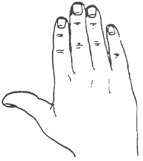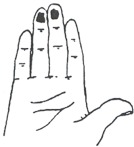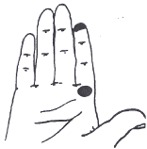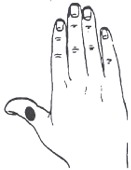Jayhawk Fitting Tips
Getting just the right fit is the most important aspect of running a pro shop. If a ball doesn’t feel right, the bowler won’t relax his hand in the ball and won’t be able to roll it properly.
Diagnosing problems with balls that a customer brings to you is an important aspect of making a customer feel confident in your ability to drill his new equipment and possibly gain you a new customer for life!! Here are some tips for checking a bowler’s hand and calluses:
The Importance of Checking the Bowler’s Hand: Any bowler who bowls too little, or too much, is bound to have problems with his or her bowling hand. The infrequent bowler does not give the hand a chance to become accustomed to the friction caused by the ball leaving the hand.
No matter how good the fit, there must be some degree of pressure on the fingers and thumb. If the bowler does not bowl often enough, blisters may form at the spots of contact. These usually are minor and develop when the occasional bowler bowls too many games in one session.
Normal Callus: An average bowler will form a callus - a hard, thickened area on the skin - wherever the fingers and thumb have contact with the ball. It is formed because of the weight bearing of the ball on certain parts of the hand. This may be good for a bowler.
Pathological Callus: Excess pressure, an ill-fitting ball, and improper use of a properly fitted ball may cause what is known as a pathological callus. This is one to worry about because it is painful and greatly hinders a bowler. The pathological callus is a hard mass of skin surrounded by an inflamed rim and it may have a deep central core like a corn. These areas do not stretch when the thumb or finger are flexed. The result is a burning sensation.
The following are examples of Pathological Calluses and other Fit Problems with a list of possible explanations for each picture
- Broken Blood Vessels Underneath Finger Nails
- Span too Long
- Hole Too Tight
- Insert Too Tight
- Excessive Forward Pitch
- Excessive Left or Right Pitch
- Holes or Inserts Too Tight
- Span Too Long
- Hole Too Tight
- Insert Too Tight
- Excessive Forward Pitch
- Span Too Short
- Inserts Worn Out
- Excessive Reverse Pitch
- Span Too Short or Too Long
- Hole Too Big
- Span Too Short or Too Long
- Hole Needs More Bevel
- Hole Too Big
- Illustrates friction points
- Finger used to support wrist
- OK unless painful
- A - Span Too Short
- A - Excessive Reverse Pitch
- B - Excessive Left Pitch
- B - Hole Too Small
- Lack of flesh between first and second thumb joints
- Hole Too Tight
- Round Hole Drilled - should be Oval
- Excessive Right Pitch
- Hole Too Small
Courtesy of Jayhawk Bowling










